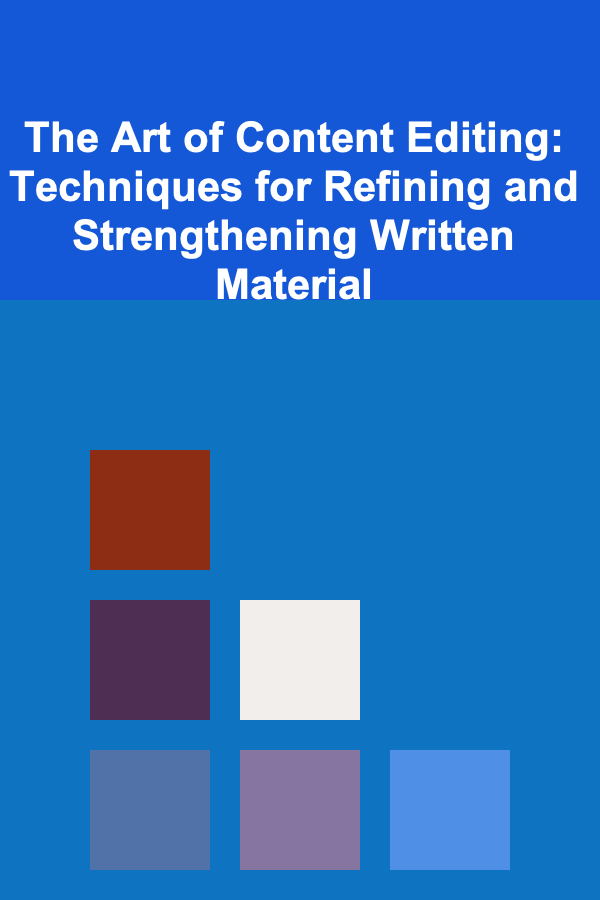
The Art of Content Editing: Techniques for Refining and Strengthening Written Material
ebook include PDF & Audio bundle (Micro Guide)
$12.99$11.99
Limited Time Offer! Order within the next:

Content editing is an essential skill that goes beyond basic proofreading. It involves a deep understanding of structure, tone, clarity, and consistency to ensure the material is engaging, coherent, and aligns with its intended purpose. Whether you are editing a blog post, an article, or a marketing piece, effective content editing is what transforms a good piece of writing into an exceptional one. In this actionable guide, we'll explore various techniques and strategies that can help you refine and strengthen your written material, making it resonate more with readers and fulfill its intended goals.
Understanding the Editorial Goals
Before diving into the editing process, it's crucial to understand the goals of the content. Every piece of writing should have a clear purpose, whether it's informing, entertaining, or persuading the reader. As a content editor, your first task is to ensure the content is aligned with these goals.
Clarify the Purpose of the Content
Ask yourself:
- What is the main message or takeaway of this content?
- Who is the target audience, and what are their needs?
- What action do we want the reader to take after reading this content?
By clarifying these questions at the outset, you ensure that all your editing decisions, from structure to tone, are purpose-driven.
Align with the Brand Voice and Tone
Every piece of content should reflect the unique voice and tone of the brand or individual it represents. Whether the tone is formal, casual, humorous, or professional, the voice should be consistent across all content. As an editor, your job is to maintain this consistency by fine-tuning sentences and adjusting phrases that deviate from the intended tone.
Enhancing Clarity and Readability
One of the most important goals of editing is to enhance the clarity and readability of the content. This means removing ambiguity, simplifying complex ideas, and ensuring that the message is communicated as effectively as possible.
Simplify Complex Sentences
Long, convoluted sentences can confuse readers. Break down complex ideas into simpler, more digestible parts. Use clear, direct language, and avoid jargon unless it's essential to the topic or audience.
Example:
- Before: "The implementation of these newly designed strategies, which will be adopted in the near future, is anticipated to significantly enhance the overall efficiency of the organization's operations."
- After: "The new strategies, set to be implemented soon, will improve the organization's efficiency."
Eliminate Redundancy
Repetition can make content feel sluggish and disengaging. Go through the material and eliminate unnecessary repetition. Look for words or ideas that have been mentioned multiple times and streamline them to keep the writing concise.
Example:
- Before: "The team worked together in a collaborative manner to complete the project on time, with all members contributing together to meet the deadline."
- After: "The team worked collaboratively to complete the project on time."
Focus on Sentence Structure
Varying sentence length and structure can improve readability and keep the reader engaged. Mix short, punchy sentences with longer, more descriptive ones. This helps maintain a natural rhythm and flow, making the content more enjoyable to read.
Example:
- Before: "The report was finished on time, and it was submitted to the client for review. The client then provided feedback, which was incorporated into the final version."
- After: "The report was completed on time and submitted to the client. Their feedback was then incorporated into the final version."
Tightening the Structure
An important aspect of editing is ensuring the structure of the content is logical and well-organized. The reader should be able to follow the argument or narrative without feeling lost. A solid structure enhances the overall flow and ensures the piece is cohesive.
Check for Clear Headings and Subheadings
Use headings and subheadings to break up long sections of text and guide the reader through the material. Each section should have a clear focus and purpose. Review the content to ensure the headings are descriptive, accurate, and aligned with the content that follows.
Maintain Logical Flow
Ensure that each paragraph leads naturally into the next, creating a smooth progression of ideas. Transitions should be clear, and sections should not feel disjointed. If a section seems out of place or interrupts the flow, move it or rewrite it to fit better with the overall structure.
Example:
- Before: "The history of the company is impressive. We also offer a wide range of products. The team consists of highly skilled individuals who are experts in their fields."
- After: "The history of the company is impressive, with a long-standing tradition of innovation. Our highly skilled team, experts in their fields, work tirelessly to create a wide range of products."
Introduce and Conclude Effectively
The introduction should grab the reader's attention and set the stage for what's to come. The conclusion should wrap up the content, providing a sense of closure and, if appropriate, a call to action. Make sure these sections serve their purpose without feeling abrupt.
Refining the Language and Style
In addition to clarity and structure, the language and style of the content play a vital role in creating an engaging piece. The words you choose can either enhance the message or detract from it, so pay close attention to the following areas during your editing process.
Use Active Voice
Active voice tends to be more engaging and direct. It makes the subject of the sentence the doer of the action, which helps create a sense of urgency and clarity. Passive voice can often seem vague and indirect, so whenever possible, switch to active voice.
Example:
- Before: "The report was completed by the team."
- After: "The team completed the report."
Avoid Overuse of Adjectives and Adverbs
While adjectives and adverbs can add detail, overusing them can make the content feel cluttered. Stick to descriptive words that add real value and contribute to the message, rather than relying on filler words that don't serve much purpose.
Example:
- Before: "The incredibly tall building is very impressive."
- After: "The towering building is impressive."
Cut Unnecessary Words
A hallmark of effective writing is conciseness. Trim any unnecessary words that don't add meaning. This will not only make the writing more efficient but also make the message more impactful.
Example:
- Before: "Due to the fact that we are behind schedule, we will need to make up for the lost time."
- After: "Because we're behind schedule, we need to make up for lost time."
Maintaining Consistency
Consistency is key in content editing. Whether it's language, tone, formatting, or style, the content should remain uniform throughout. This ensures that the piece is professional and cohesive.
Check for Consistent Terminology
Ensure that terms are used consistently throughout the content. If you're writing about a specific topic or industry, use standard terminology to avoid confusion. If different terms are being used to refer to the same thing, choose one and stick to it.
Example:
- Inconsistent: "The customer service team" and "The support team"
- Consistent: "The customer service team"
Adhere to Style Guides
If the content is part of a larger project or brand, ensure that it follows any relevant style guides. This includes rules for grammar, punctuation, and formatting. Whether it's an internal company style guide or an external standard like AP or Chicago, consistency in these areas strengthens the content's professionalism.
Review Formatting
Formatting plays a huge role in ensuring the content is accessible and easy to navigate. Make sure the font is consistent, headers are appropriately sized, and the overall layout is clean. A well-formatted document helps maintain reader focus and improves engagement.
Polishing the Final Product
After addressing the major elements of clarity, structure, language, and consistency, it's time for the final polish. This step involves fine-tuning the details, ensuring everything is accurate, and checking for minor errors that might have been missed during the initial review.
Proofread for Grammar and Spelling
Even the best writers make mistakes, so it's essential to proofread the content thoroughly. Look for common grammar and spelling issues, such as subject-verb agreement errors, incorrect punctuation, and typographical errors. Tools like Grammarly or Hemingway can be helpful, but a manual review is still essential.
Read Aloud
Reading the content aloud is a powerful technique for catching awkward phrasing, unnatural sentence flow, and other issues that might be missed during silent reading. Hearing the content can give you a fresh perspective and help identify areas for improvement.
Get Feedback
If possible, have someone else review the content. A fresh pair of eyes can spot errors or inconsistencies that you might have overlooked. Feedback from others also helps ensure the content resonates with the intended audience.
Conclusion
Content editing is an art form that requires a mix of technical skills, creativity, and attention to detail. By focusing on clarity, structure, language, consistency, and polishing the final product, you can refine and strengthen your content to make it more effective, engaging, and impactful. Whether you're editing for a blog, a website, or any other form of written communication, mastering the art of content editing will elevate your work and ensure it resonates with your audience. By applying these techniques, you can transform good writing into great writing that achieves its goals and stands out in the digital landscape.
Reading More From Our Other Websites
- [Scrapbooking Tip 101] Step-by-Step Guide: Designing Balanced Scrapbook Pages for Beginners
- [Organization Tip 101] How to Organize Your Child's School Year Supplies
- [Personal Finance Management 101] How to Create a Personalized Budget Using the Best Personal Finance Management Apps
- [Gardening 101] Top 5 Garden Gloves That Offer Maximum Protection and Comfort
- [Home Security 101] How to Set Up Security Cameras Without a Subscription for Continuous Monitoring
- [Needle Felting Tip 101] How to Design Custom Felted Jewelry Using Metal Wire and Beads
- [Personal Care Tips 101] How to Remove Makeup Quickly Without Overuse of Products
- [Home Pet Care 101] Recognizing and Treating Pet Anxiety
- [Stamp Making Tip 101] Retro Revival: How Vintage Patterns Can Spark Modern Stamp-Making Projects
- [Gardening 101] Garden Life Inspiration: Transform Your Backyard into a Peaceful Retreat

How to Choose the Best Lighting Fixtures for Your Home Renovation
Read More
How To Develop Your Character's Motivations
Read More
How to Handle Security Deposits in Rental Properties
Read More
How to Plan a Family Virtual Game Night with Friends
Read More
Smart Ways for Lowering Cell Phone Bills Without Losing Features
Read More
How to Write Marketing Copy That Sells
Read MoreOther Products

How to Choose the Best Lighting Fixtures for Your Home Renovation
Read More
How To Develop Your Character's Motivations
Read More
How to Handle Security Deposits in Rental Properties
Read More
How to Plan a Family Virtual Game Night with Friends
Read More
Smart Ways for Lowering Cell Phone Bills Without Losing Features
Read More